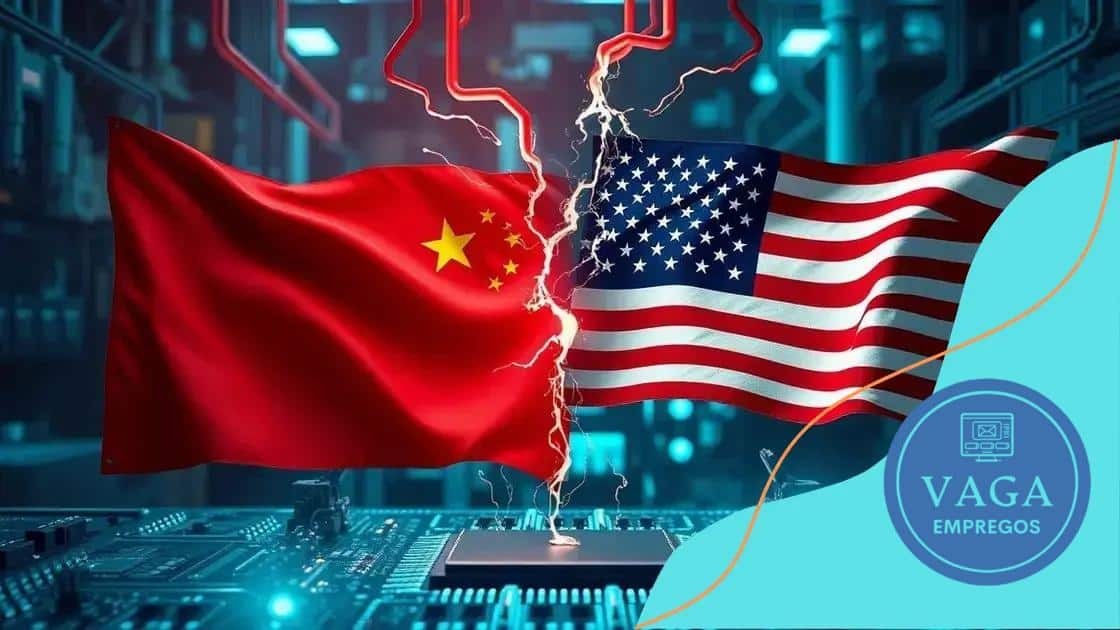China-U.S. tensions escalate over semiconductor access

Advertisement
China-U.S. tensions escalate over semiconductor access, impacting global supply chains, driving both nations to invest in domestic industries, and potentially leading to technological decoupling between the two countries.
China-U.S. tensions escalate over semiconductor access, creating ripples across industries worldwide. How does this affect technology developments and global markets? Let’s explore the intricacies behind this unfolding situation.
Advertisement
Overview of semiconductor industries in China and the U.S.
The semiconductor industries in both China and the U.S. are crucial to the global technology landscape. Semiconductors are essential components in everything from smartphones to advanced computing systems. Understanding how these industries operate helps to shed light on the growing tensions between the two nations.
Advertisement
Overview of the U.S. Semiconductor Industry
The U.S. has long been a leader in semiconductor production, hosting some of the world’s largest technology firms. Major companies like Intel and Nvidia play a pivotal role in innovation and manufacturing. The U.S. government also supports this sector through research funding and policies.Challenges facing the U.S. include increasing competition from other nations and supply chain vulnerabilities.
Overview of the Chinese Semiconductor Industry
In recent years, China has made significant investments to boost its semiconductor industry. The government has implemented aggressive strategies to reduce dependence on foreign technology. Companies like SMIC are striving to advance their processes and capabilities. However, challenges remain, including limited access to advanced manufacturing technologies.
- Strong government backing for research and development in China.
- Emerging tech firms in China are competing on a global scale.
- Increased collaboration with other nations for technology sharing.
The interdependence of these two industries reflects the intricate nature of global tech supply chains. As the U.S. adopts stricter export controls, it will likely impact China’s semiconductor ambitions. This system highlights the broader implications of the ongoing China-U.S. tensions.
The competition in the semiconductor sector is about more than just economics; it’s also tied to national security. As both countries work to secure their technological futures, the stakes are high. Cooperation and competition will shape the future landscape of the global semiconductor market.
Impact of trade policies on semiconductor technology
The impact of trade policies on semiconductor technology is significant and constantly evolving. As countries implement various measures, the effects ripple through the global supply chain, influencing production, innovation, and competition.
U.S. Trade Policies and Their Effects
The United States has introduced several trade policies aimed at protecting its semiconductor industry. These policies include tariffs and export controls that target specific countries and technologies. For instance, restrictions on the export of advanced chip-making equipment to China play a crucial role in slowing down its technological advancements.
- Protection of intellectual property is a major focus.
- Policies encourage domestic production and innovation.
- Export controls impact international collaborations.
While these policies are designed to bolster national security and maintain a competitive edge, they can also lead to unintended consequences. Companies may face challenges in sourcing materials or collaborating with international firms, which can hinder innovation.
China’s Response to Trade Barriers
In response to U.S. trade policies, China has ramped up its efforts to develop a self-sufficient semiconductor industry. The Chinese government has invested heavily in research and development to close the technological gap. Initiatives like “Made in China 2025” aim to enhance domestic production of semiconductors.
Chinese companies are also seeking partnerships with nations that offer advanced technology to counter U.S. restrictions. This strategy highlights how trade policies can accelerate competition rather than deter it.
Moreover, the impact goes beyond the two nations. Countries that are part of the semiconductor supply chain must adapt to these policies. Manufacturers in Taiwan and South Korea constantly navigate the changing landscape to manage their relationships with both the U.S. and China. As global demand for chips surges, balancing these trade policies becomes increasingly complex.
Key players in the semiconductor conflict
Identifying the key players in the semiconductor conflict helps us understand the dynamics of the issue. Both the United States and China have significant companies and government entities playing crucial roles in this sector.
Major Companies in the U.S.
In the United States, companies like Intel, Qualcomm, and Nvidia are at the forefront of semiconductor technology. These firms are not only leaders in chip production but also in innovation. Their research and development efforts are essential for maintaining the U.S.’s competitive edge.
- Intel: Dominates the CPU market and invests heavily in new technologies.
- Qualcomm: A leader in mobile chipsets and wireless technology.
- Nvidia: Known for graphics processing units (GPUs) and AI tech.
These companies are affected by trade policies, as restrictions can hinder their ability to source materials or collaborate internationally.
Significant Entities in China
China, on the other hand, boasts key players like Huawei, SMIC (Semiconductor Manufacturing International Corporation), and BYD. These companies are making strides to compete with their U.S. counterparts. For instance, despite facing sanctions, Huawei continues to advance its technology and seeks alternative supply sources.
SMIC is crucial for China’s semiconductor strategy, responsible for many high-tech chip manufacturing processes. As China aims for self-sufficiency, these players become increasingly significant in the global context.
Both nations are not just competing economically but also in areas like national security. The semiconductor industry has become vital for technological independence, making the stakes higher. Various countries are closely watching the actions of these key players as they navigate this rapidly changing landscape.
Potential consequences for global tech supply chains
The potential consequences for global tech supply chains stemming from the ongoing semiconductor conflict are significant. As the U.S. and China battle for dominance in this critical industry, the repercussions can be felt worldwide.
Disruption in Supply Chains
One of the primary consequences is the disruption of existing supply chains. Many companies rely on a seamless flow of components from different countries. As trade tensions rise, manufacturers may face delays and higher costs.
- Export restrictions can limit access to essential technology.
- Increased tariffs can raise production expenses.
- Companies may need to find alternative suppliers, complicating logistics.
This uncertainty can lead to longer lead times for products and fluctuation in market prices, affecting consumers directly.
Shift in Manufacturing Locations
Another outcome could be a gradual shift in where tech products are manufactured. As companies assess risk, they might relocate their production to more stable regions. This move can cause significant changes in local economies and labor markets.
For example, countries in Southeast Asia may experience a surge in manufacturing as companies look for alternatives to Chinese production. This shift highlights the need for businesses to remain flexible and adaptable in the face of changing geopolitical conditions.
Furthermore, the race for technological independence will likely prompt nations to invest heavily in their semiconductor capabilities. Countries that can innovate and build local supply chains will gain a competitive edge, which can further reshape global tech dynamics.
As these trends develop, the very fabric of global technology supply chains will evolve. Companies that anticipate and adapt to these changes will be better positioned to thrive in a rapidly shifting landscape.
Future outlook for China-U.S. semiconductor relations
The future outlook for China-U.S. semiconductor relations holds numerous uncertainties and potential shifts that could impact the global tech landscape. As both nations navigate their growing rivalry, key factors will likely shape their interactions.
Technological Decoupling
One prominent trend is the potential for technological decoupling. This concept suggests that the U.S. and China may increasingly diverge in technological standards and supply chains. As companies seek to secure access to critical components, innovation could be stifled due to reduced collaboration.
- Different regulatory environments may create barriers to cooperation.
- Companies might face challenges when trying to operate in both markets.
- Intellectual property issues may escalate, leading to more disputes.
This separation can lead to two distinct technological ecosystems, each with unique standards and practices, making it harder for firms to operate globally.
Investment in Domestic Capabilities
In the face of competition, both countries are likely to invest significantly in their domestic semiconductor industries. The U.S. is focusing on bolstering its manufacturing base through funding initiatives and incentives. Programs like the CHIPS Act aim to promote domestic chip production and reduce reliance on foreign suppliers.
China is also ramping up efforts to strengthen its semiconductor ecosystem. Through government funding and policy support, companies are encouraged to innovate and produce more advanced technologies independently. This push for self-sufficiency will be critical for China’s long-term strategy.
As these investments unfold, the rivalry will intensify, potentially leading to even greater advancements in semiconductor technology. Companies that adapt quickly to changing policies will have better chances to thrive.
In conclusion, while the future remains uncertain, the evolving dynamics of China-U.S. semiconductor relations will continue to shape the technological landscape, influencing market strategies and global competition.
The semiconductor conflict between China and the U.S. is reshaping the global tech landscape. As trade tensions continue, both nations are investing in their industries to secure their technological futures. This rivalry not only influences market dynamics but also impacts international relations. The outcome will determine how technology develops and is shared across the world. Companies must remain agile to adapt to this evolving environment, balancing competition with opportunities for collaboration.
FAQ – Frequently Asked Questions about China-U.S. Semiconductor Relations
What are the main causes of the tensions between China and the U.S. regarding semiconductors?
The tensions are primarily driven by trade policies, national security concerns, and competition for technological leadership in the semiconductor industry.
How do U.S. trade policies affect the semiconductor industry?
U.S. trade policies, including tariffs and export controls, can limit access to essential technologies and materials, impacting production and innovation in both the U.S. and China.
What is the significance of investing in domestic semiconductor capabilities?
Investing in domestic semiconductor capabilities allows countries to reduce reliance on foreign suppliers, enhance national security, and foster innovation within their tech industries.
What might the future hold for global tech supply chains due to this conflict?
The future could see disruptions in supply chains, shifts in manufacturing locations, and the emergence of separate technological ecosystems, influencing global markets significantly.





